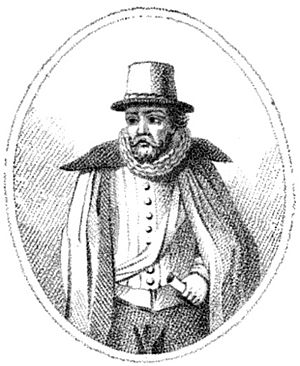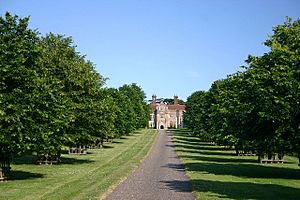Ambrose Rookwood facts for kids
Quick facts for kids
Ambrose Rookwood
|
|
|---|---|

Early 19th-century portrait of Rookwood
|
|
| Born | c. 1578 Suffolk, England
|
| Died | 31 January 1606 (aged 27–28) Westminster, London, England
|
| Occupation | Horse-breeder |
| Spouse(s) | Elizabeth Tyrwhitt |
| Children | Robert and Henry |
| Parent(s) | Robert Rookwood Dorothea Drury |
| Motive | Gunpowder plot, a conspiracy to assassinate King James I and members of the Houses of Parliament |
| Conviction(s) | High treason |
| Criminal penalty | Hanged, drawn and quartered |
| Role | Uprising |
|
Date apprehended
|
8 November 1605 |
Ambrose Rookwood (born around 1578 – died January 31, 1606) was involved in the famous 1605 Gunpowder Plot. This was a secret plan to replace the Protestant King James I with a Catholic ruler. Ambrose came from a rich Catholic family. He was educated by Jesuits in Flanders. His family was known for their strong Catholic faith.
Ambrose became a horse-breeder. He married Elizabeth Tyrwhitt, who was also Catholic. They had at least two sons. In September 1605, a man named Robert Catesby asked Rookwood to join the plot. Catesby was very religious and was upset with how King James treated English Catholics. He planned to blow up the House of Lords with gunpowder. This would kill the king and many important Protestant leaders. Catesby also wanted to start a rebellion in the Midlands. During this uprising, King James's nine-year-old daughter, Princess Elizabeth, would be captured. She would then be made queen. Rookwood's fast horses were very important for this rebellion to work.
The explosion was supposed to happen on November 5, 1605, when Parliament opened. But the person guarding the gunpowder, Guy Fawkes, was found and arrested. Rookwood quickly left London and told Catesby that the plan had failed. The remaining plotters rode to Holbeche House in Staffordshire. On November 8, they were attacked by the Sheriff of Worcester and his men. Catesby was killed, but Rookwood survived. He was then sent to the Tower of London.
Rookwood and the other survivors were put on trial on January 27, 1606, in Westminster Hall. He said he was not guilty and that he loved Catesby "more than any other person." He was found guilty. His request for mercy was not granted. He was given a very harsh punishment for serious crimes against the king on January 31, in the Old Palace Yard at Westminster.
Contents
Ambrose Rookwood's Life and Beliefs
Ambrose Rookwood was born around 1578. He was the second of four sons of Robert Rookwood and his second wife, Dorothy Drury. The Rookwood family had lived in Stanningfield in Suffolk for 300 years. They were a wealthy family and strong Catholics. The authorities often saw them as troublemakers because of their faith.
Ambrose's parents had been put in prison for being Catholic. He was also accused of the same thing in February 1605. He seemed proud to show his faith. In the summer of 1605, he had a special sword made. It had a Spanish blade and a handle carved with the story of Jesus's suffering. Such swords were usually worn in public. This was a bold statement of his Catholic beliefs.
Ambrose and two of his brothers, Robert and Christopher, went to school with Jesuits in Saint-Omer, which was then in Flanders. Both brothers became priests. Ambrose's older brother, Henry, became a Franciscan monk. His half-sisters, Dorothea and Susanna, became nuns. A Jesuit named Oswald Tesimond described Rookwood as "well-built and handsome, if somewhat short." He liked to wear fancy clothes.
Family and Early Troubles
Around 1599, Ambrose married Elizabeth Tyrwhitt. She was from another important Roman Catholic family in Lincolnshire. They had two sons, Robert and Henry.
When his father died in 1600, Ambrose inherited Coldham Hall. This house became a safe place for Catholic priests. The next year, he joined the Earl of Essex's rebellion against the government. He was caught and held in Newgate Prison.
Joining the Gunpowder Plot
In August 1605, Rookwood went on a religious trip with Jesuits Henry Garnet and John Gerard. Later in September, Robert Catesby, Thomas Wintour, and John Wright asked him to join the Gunpowder Plot. English Catholics had hoped that King James I would be kinder to them when he became king. But Catesby felt that James had broken his promises.
Catesby planned to kill the king by blowing up the House of Lords with gunpowder. Then, he wanted to start a revolt to make James's daughter, Elizabeth, queen. He had already gathered nine Catholics for the plan. But he needed more money and more men. Rookwood was a horse-breeder, and his stable of fine horses at Coldham Hall was needed for the uprising in the Midlands. He had been asked to provide gunpowder about a year earlier, pretending it was for a soldier's group in Flanders. But he did not give money to the plot.
Rookwood was worried about the Catholic lords who would be in Parliament during the explosion. But Catesby promised him that they would be tricked into staying away that day. Catesby also lied, saying that the Jesuits had approved the plan. This made Rookwood feel better. Rookwood rented Clopton House near Stratford upon Avon and moved there. He brought many Catholic religious items with him, like chalices and crucifixes. These were hidden in a secret cellar.
A few days before the planned explosion, Rookwood changed his mind about the special sword he had ordered. He had the sword maker replace the handle with a gold one. This fancy sword cost him a lot of money. It was delivered on November 4.
The Plot Unravels
The plot was discovered because an anonymous letter was sent to William Parker, 4th Baron Monteagle. The letter warned him to stay away from Parliament. On the evening of November 4, the authorities searched the House of Lords. They found Guy Fawkes guarding a large amount of explosives. He was arrested right away.
Fawkes had pretended to be a servant of another plotter, Thomas Percy. So, the first arrest warrant was for Percy. News of Fawkes's capture quickly spread. Christopher Wright told Thomas Wintour what had happened. Wintour guessed they were looking for Percy and told Wright to warn him to leave. Wintour, Christopher Wright, Percy, Robert Keyes, and Rookwood all left London. Rookwood was a very good horseman. He rode 30 miles in two hours on one horse. Using different horses he had placed along the way, he passed Keyes, then Wright and Percy. He caught up with Catesby, who had left the day before to prepare the uprising. Rookwood told Catesby what had happened in London. The group, which now included Catesby, his servant Thomas Bates, both Wright brothers, Percy, and Rookwood, rode to Dunchurch.
While Fawkes was being questioned, the government started to arrest anyone they thought was involved. Rookwood's servants were questioned. His belongings at Clopton, including the Catholic symbols, were also taken. By the time the plotters reached Catesby's family home, Rookwood's name was on the list of suspects. The fugitives continued to Dunchurch, where they met Everard Digby and his hunting party. The next day, the group stole horses from Warwick Castle. They then gathered weapons and continued to Huddington. They tried to get more people to join them, but no one wanted to risk being called a traitor. Father Garnet, a priest, wrote to Catesby, telling the group to stop their "wicked actions."
Fugitive and Capture
Rookwood was declared a wanted man on November 7. He went to confession and took a religious vow with the rest of the group. This showed they believed they did not have long to live. They rode through heavy rain to Hewell Grange, taking more weapons, ammunition, and money. Finally, they reached Holbeche House at about 10:00 pm. They were tired from three days of riding. They spread some wet gunpowder from Hewell Grange in front of the fire to dry it. A spark landed on the powder, causing an explosion. Rookwood, Catesby, John Grant, and another man were caught in the blast. Rookwood and Catesby were "reasonably well," but Grant was blinded.
Some of the plotters left during the night. But Rookwood, Catesby, the Wright brothers, Percy, and Grant stayed. By 11:00 am the next day, the house was surrounded by 200 of the Sheriff of Worcester's men. In the fight that followed, Wintour was shot. John and Christopher Wright were killed. Catesby and Percy were both reportedly killed by a single shot. Rookwood was also shot, but he survived and was quickly captured. His fancy sword disappeared, likely taken by the Sheriff's men. Rookwood and the others were taken first to Worcester, then to the Tower of London. The other plotters who were still free were caught soon after.
Trial and Execution
The king and his family secretly watched the trial of the surviving plotters. It took place in Westminster Hall on January 27, 1606. Some prisoners looked sad, while others seemed not to care. All except Digby said they were "Not Guilty." Rookwood defended himself, saying he joined the plot because of his friendship with Catesby, "whom he loved more than any other person." He admitted he did not expect mercy but asked for it anyway. He did not want to leave a "stain" on his family's name forever.
His pleas did not work. The jury found him guilty, and he was sentenced to death. Three days later, Digby, Robert Wintour, John Grant, and Thomas Bates were given a very harsh punishment for serious crimes against the king at St Paul's churchyard. The next day, Rookwood, Thomas Wintour, Robert Keyes, and Guy Fawkes were tied to wooden frames. Horses dragged them from the Tower to the Old Palace Yard at Westminster. This was a longer route than their friends had taken.
Rookwood had asked to be told when he passed his home in the Strand. He wanted to open his eyes and see his wife, who was waiting at the window. He shouted, "Pray for me, pray for me!" According to Father Gerard, Elizabeth answered, "I will, and be brave. Give yourself completely to God. I, for my part, give you back to God as freely as He gave you to me." For the rest of the journey, he kept his eyes closed and prayed. Thomas Wintour was the first to be executed that day. Rookwood was next. He gave a short speech to the crowd. He said he was sorry and asked God to bless the king, queen, and their children. But he also asked God to make the king a Catholic. He seemed to have been left hanging for longer than the others before the rest of his punishment was carried out.


